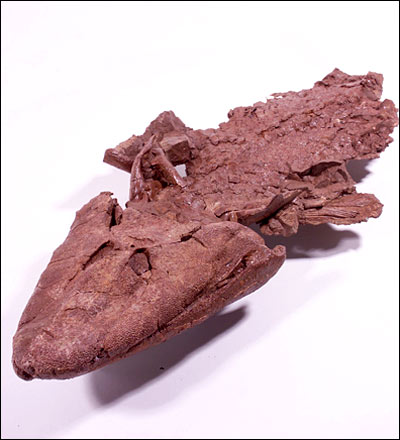Avi Blizovsky

Now there is a new weapon against the deniers of evolution - scientists have discovered a fossil of a fish that was in the middle of the transition to life on land. The discovery sheds new light on one of the greatest transformation processes in the history of animals.
The scientists, who reported the finding in the journal Nature, believe that a species of fish was the first to land on land and use four legs about 4 million years ago, but so far they have not found enough evidence to document how this process was carried out.
The new findings of a number of individuals that look like land dwellers and some fossils of fish that have received the scientific name "Tiktaalik roseae" that appear to be in transitional stages and the researchers estimate that they made short trips outside the water.
"These fossils seem to blur the line between fish and land creatures." said one of the discoverers, Prof. Neil Chaubin, a paleontologist from the University of Chicago.
The experts say that the discovery, a complete skeleton preserved almost intact, reveals significant new information about the way the transition from water to land was made during evolution. "The discovery makes renewed contributions to the understanding of a very important transition in the history of life," says Robert Carroll of McGill University in Montreal.
The findings are of individuals with a length of 1-3 meters found on Ilsmere Island, located north of the Arctic Circle in Canada. About 375 million years ago, there lived a creature that looked like a cross between a fish and a crocodile. He swam in shallow currents in what was then an area with a subtropical climate. It was a meat eater that lived mainly in water. However, its front includes bones corresponding to the shoulder, upper arm, elbow, forearm and a primitive version of the wrist. "From the shoulder to the palm of the hand it looks like an arm." Chauvin said.
"This fish had a fin that allowed it to push." said. "It was clearly an animal that could support itself on the ground. Both in areas where the water was very shallow and in small forays to land. There he apparently moves like a seal. said.
"This is a fish that includes, surprisingly, characteristics of terrestrial animals," said Neil Chauvin of the University of Chicago, who led the research team. He added that "this animal represents the transition from water to land - and to us."
The almost complete and well-preserved items show that the creature was blessed with new teeth, a jaw ranging in diameter from 25 to 50 cm and a flattened body that reached up to three meters in length.
According to the researchers, "Previous fossils we found in the context of this evolutionary stage were fish with few terrestrial characteristics, or terrestrial vertebrates with only residual marine characteristics. These fossils show a creature that sat right in the middle, between a fish and a land animal."
"This finding is a dream come true," concluded Ted Deischler, from the Academy of Natural Sciences in Philadelphia. adding that the fossils also prove that the transition from sea to land happened gradually, in fish that lived in shallow water. These gradually developed characteristics that allowed them to live on land.
They know evolution - fossils
For news at the BBC
https://www.hayadan.org.il/BuildaGate4/general2/data_card.php?Cat=~~~445330223~~~153&SiteName=hayadan
